08.06.03 Mk. 5:1-20 (See also Mt. 8:28-34; Lk. 8:26-39) Gerasa in Gadara
DEMON-POSSESSED GERASENE
1 Then they came to the other side of the sea, to the region of the Gerasenes. 2 As soon as He got out of the boat, a man with an unclean spirit came out of the tombs and met Him. 3 He lived in the tombs. No one was able to restrain him anymore — even with chains — 4 because he often had been bound with shackles and chains, but had snapped off the chains and smashed the shackles. No one was strong enough to subdue him. 5 And always, night and day, he was crying out among the tombs and in the mountains and cutting himself with stones.
6 When he saw Jesus from a distance, he ran and knelt down before Him. 7 And he cried out with a loud voice, “What do You have to do with me, Jesus, Son of the Most High God? I beg You before God, don’t torment me!” 8 For He had told him, “Come out of the man, you unclean spirit!”
9 “What is your name?” He asked him.
“My name is Legion,” he answered Him, “because we are many.” 10 And he kept begging Him not to send them out of the region.
11 Now a large herd of pigs was there, feeding on the hillside. 12 The demons begged Him, “Send us to the pigs, so we may enter them.” 13 And He gave them permission. Then the unclean spirits came out and entered the pigs, and the herd of about 2,000 rushed down the steep bank into the sea and drowned there. 14 The men who tended them ran off and reported it in the town and the countryside, and people went to see what had happened.15 They came to Jesus and saw the man who had been demon-possessed by the legion, sitting there, dressed and in his right mind; and they were afraid. 16 The eyewitnesses described to them what had happened to the demon-possessed man and told about the pigs. 17 Then they began to beg Him to leave their region.
18 As He was getting into the boat, the man who had been demon-possessed kept begging Him to be with Him. 19 But He would not let him; instead, He told him, “Go back home to your own people, and report to them how much the Lord has done for you and how He has had mercy on you.” 20 So he went out and began to proclaim in the Decapolis how much Jesus had done for him, and they were all amazed.
This passage is in need of cultural and historical explanations which are below the explanations of the underlined verses.
“Even with chains.” The encounter Jesus had with the demoniac certainly had a profound influence on the Jewish people, as they reflected upon the story of the ancient super-strong man named Samson. He was chained to a Philistine pillar until God restored his strength and he moved the pillar causing the pagan temple to collapse. Now Jesus confronted a man who apparently was stronger than Samson – as no chains could hold him, and Jesus freed him of his demonic powers and healed him.

“Cutting himself with stones.” The fact that he was cutting himself suggests that he was afflicted by what some call, “suicidal spirits.” Satan and his demons not only attempt to thwart the plan of God, but also seek to kill and destroy people because they were created in God’s image. Little wonder then, that the suicidal demons entered a herd of pigs who immediately committed suicide.
“I beg You before God, don’t torment me!” The spirit spoke using the man’s body. Jesus would not torture anyone, but the demons know that one day they will be thrown into an everlasting lake of fire (Rev. 20:10). All Scriptures agree that judgment of angels and demonic spirits is yet to come (1 Cor. 6:3); they will be in chains and darkness until their final judgment day (Jude 6).
“What is your name?” The question is one of authority and not a request for information. Jesus always took immediate command of a situation and the demons obeyed.
“My name is Legion.” Precisely how the demon responded is unknown, but he probably identified himself with the name of ligyona, the Aramaic name for soldier. Or he could have identified himself with a short statement that included all the other spirits.[1] It seems ironic that the response to the question was “Legion” as he did not give the name his parents gave him, but rather, he identified himself with the demons.
Gadara was the home for the the famous Legio X Fretensis, or Legio Dicima Fretenis, better known as the Tenth Roman Legion.[2] Did the demons have a spiritual connection with the pagan Roman soldiers stationed at Gadara? Every Roman military unit traveled with its pagan priests who prayed and offered sacrifices on behalf of the troops.[3] Clearly there appears to have been a spiritual connection to not only the legion, but also to the area of Gadara.
“And he kept begging Him not to send them out of the region.” Why would the demons beg Jesus not to send them out of the area? According to Jewish tradition, some evil spirits were assigned to various regions. Hence, some of them have become known as “territorial demons.”[4]
“The man who had been demon-possessed.” Those who are demon-possessed often lose their ability to separate their own consciousness and ideas from those of demonic influence. The person’s identity is blended into that of a demon and the demon has some control of the individual’s mind and body.[5] In severe cases, the demon has complete control. Jesus always spoke of demoniacs, not as persons with mental disorders, but as those who had alien spirits. Jesus addresses the evil spirit as distinct from the man (demoniac), when He commanded the spirit to come out of him.
The belief in demons was so common, along with the number of people who claimed to be exorcists, that by the year 340 the church established the Order of Exorcists, to properly control those who claimed to have the power of performing such acts.[6] To this day the Roman Catholic Church, as well as many other denominations, train individuals who perform exorcisms.[7]
Finally, Luke, a professional medical doctor, clarified the distinctions between diseases and demonic possession four times.[8] He did not do so in this passage because there were no sick people present, only those afflicted with demonic spirits.
“Report to them how much the Lord has done for you.” This instruction is in sharp contrast to the previous command of silence Jesus gave to the Jews whom He healed (i.e. Mk. 1:40-45; 5:43). A difference between the Greeks and Jews was that the Greeks did not have any problem living in a decadent culture and believing in a Messiah who could deliver them; the exorcism did not challenge their religious traditions.
“He has had mercy on you.” Clearly, Jesus acted as the God of Mercy, or as the Jews would have said, Elohe Chaseddi.[9] Anyone could have claimed to have been god, as pharaohs, emperors, and kings have done throughout history, but Jesus refrained from stating it, but demonstrated that He is God.
Now, as to important cultural and historical explanations, the Greek city of Gerasa was an important commercial and military center for the Romans. Archaeological investigations have revealed that it was among the finest Decapolis cities and it was located along a major caravan route. It had public baths, a theater near its splendid baths, two great amphitheaters, several temples, a hippodrome, and mile after mile of colonnaded streets with a triumphal arch – all of which revealed the splendor of Greek philosophy and Roman might. Roman soldiers and cavalry units protected the caravan routes and cities from Bedouin hordes and robber bands.
Gadara was a famous fortified city that some ancients said was as Hellenistic as Athens. It was the capital of a toparchy[10] and minted its own currency. Alexander Jannaeus laid siege against it for ten months, finally destroying it.[11] But it was rebuilt by General Pompey. It belonged to the Kingdom of Herod the Great, but upon his death the Roman senate made it part of Syria.[12]
On occasion Jesus and His disciples sailed across the Sea of Galilee to the eastern side near Gerasa to the harbor of Gadara. Before them were the rocky cavern-tombs of the Wadi Semakh. As was so often done until recent times, since the caverns are cool in the oppressive summer heat and warm in the cold winter, they were used as homes or for the back room of homes. A visitor to this region in the 1890s reported that as many as two hundred Arabs lived in caves and former tombs along this wadi. Smaller caves were used as tombs, but larger subterranean dwelling places could accommodate twenty to thirty people. Many of these earthly caverns, which were originally smaller caves and tombs, were enlarged since the soft limestone was easy to remove.[13]
The fact that a deranged man lived in a cavern was not unusual; but that he chose to live in a cavern that was used as a tomb, was unusual. Those who attended to the herd of pigs were probably also cavern dwellers, although the description of this demon-possessed individual would indicate he did not appreciate close neighbors.
Previous attempts to bind or control him had failed. Clearly his behavior suggests that his super-human strength was of a demonic source. Suddenly a boatload of visitors arrived at the harbor and the frightful, naked, and homicidal maniac came forth to greet them. A second demoniac also arrived, but apparently stayed some distance away and played no part in the narrative. The first demoniac immediately recognized Jesus and came to Him.[14]
The residents of Gadara were, for the most part, employed in supplying the Tenth Roman Legion, the Legio Dicima Fretenis,[15] with daily supplies of food and other necessities. Since pork was the primary meat staple of the Romans, raising a huge herd of two thousand swine is understandable. Some have said that pigs were raised in the city proper and the herd ran the distance of six miles into the Sea of Galilee. There are several reasons for this not to be the case. Rather, the pigs were raised near the sea itself.
- Pigs do not have sweat glands, so they must always be near water or mud to cool themselves. This is especially true in the Galilee area where the summers are rather hot, and without proper cooling, they die quickly.
- While wild pigs, known as boars, are extremely vicious and have a great capacity to run while domesticated pigs have limited physical endurance. Therefore, they could not have run the huge distance from the city to the sea.
- Pigs produce pungent odors. Two thousand of them, even in an open space, would produce an unbearable fragrance that even the ancients could not tolerate. They would not be welcomed guests in any community.
- Pigs like to eat acorns, the nuts from oak trees. The Golan Heights and nearby plateau was covered with oak trees, whereas, the root systems of these trees tend to break up building foundations, so these trees are not planted close to buildings in cities.
Yet pigs were a primary meat staple throughout history in other non-Jewish cultures as well. They were a quick supply of meat, as the time required from birth to slaughter is only about six or seven months. Ironically, the Tenth Legion had the image of a wild boar on its military standard. The effigy did not represent their favorite delicacy, but the viciousness, speed, and tenacity that a wild boar exhibited when fighting. This wild unkosher beast was not only the symbol of the Tenth Legion, but when the soldiers constructed buildings, they often placed their Tenth Legion symbol (“LEG-X-F”) somewhere on the building, and sometimes it was with the image of their mascot.[16]
In addition to supplying meat, the city residents also supplied wheat for bread and barley for horses. Local craftsmen built and repaired necessary military supplies that not only served the regiments in the immediate area, but were also shipped to Damascus and other Tenth Roman Legion posts. Supplies were shipped by camel caravans to points north, east, and west. For west-bound supplies, Gergesa had the largest artificial port along the Sea of Galilee – the harbor of Gadara. Supplies were loaded on freight ships that sailed to the western shore from which caravans transferred the cargo to the Mediterranean Sea for overseas destinations.
As to the biblical passage, Jesus encountered an outcast who lived in the tombs. He cast out demons because evil spirits are real; not the result of superstitions. Luke recorded that the seven sons of Sceva used the name of Jesus as if it were a magical formula for exorcism (Acts 19:13-16) and had no desired results. The Greeks sacrificed pigs to appease the gods, but Jesus not only demonstrated that He is the only atonement for sin, but that He had complete authority and power over every demonic spirit.
Demons are synonymous with unclean spirits,[17] who are connected with Satan,[18] are in total opposition to God and the work of God[19] and as such, promote all forms of idolatry.[20] They oppose the faith of believers,[21] and attempt to influence and disturb the physical, mental and emotional well-being of people.[22] However, while certain ailments may be connected with demonic powers, the laws of Moses that pertain to sanitation clearly indicate that good health is also a matter of cleanliness – meaning that many diseases are not related to demonic influences, but can be prevented.
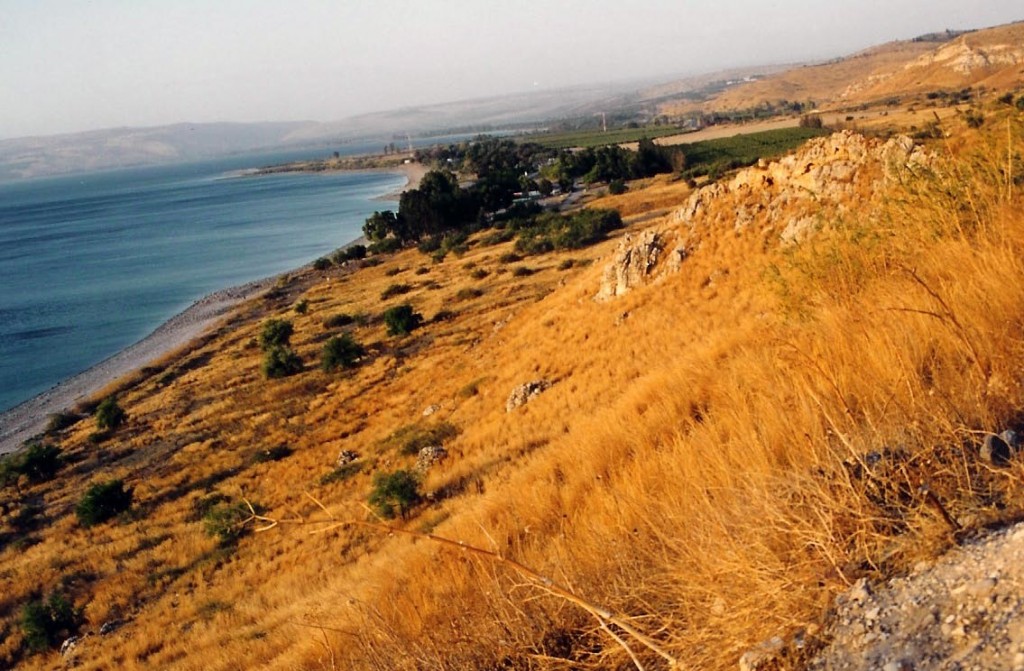
08.06.03.A. HILL OF THE SWINE. This is one of two steep hillsides along the eastern shore of the Sea of Galilee where this miracle could have taken place. The area was inhabited by Greeks, who raised sacrificial pigs for the worship of Zeus in the nearby city of Gadara. Photograph by the author.
The location of the miracle is debated among scholars, as there are two possible locations.
- Some believe the miracle took place along the eastern shore of the Sea of Galilee at a place known today as Kursi. Queen Helena, who, in the early fourth century, built a Byzantine chapel nearby, preserved the site. However, the site was abandoned after a devastating earthquake on January 18, 749 (estimated 6.6 Richter scale),[23] and was forgotten until accidentally discovered and identified in 1970.[24] It is a short distance from a steep hillside, the only one in this part of the lake that fits the description of where the pigs could have rushed down into the water (8:32). However, there is no harbor at this location, and the shoreline is too rocky to land a boat without causing severe damage.
- The second possible site of the miracle is the harbor of Gadara. Harbors are generally part of a village or city with considerable commercial activity. However, at this harbor, to date archaeologist have not uncovered any evidence of human occupation and Gadara is about six miles to the southeast (in modern Jordan). Ironically, of the fifteen harbors along the perimeter of the Sea of Galilee, the Gadara harbor is the largest – some 200 meters (600 feet+) long.
Gadara was an important Decapolis city[25] as it was a major supplier of goods and services to the Tenth Roman Legion. Its harbor along the Sea of Galilee was the largest on the lake, and could accommodate the variety of ships, especially the larger grain ships.[26] Coins have been found with the word “Naumachia” featuring mock naval battles in their fishing harbor.[27] Obviously this was not an ordinary village. It was one of the many “backbones” for the Tenth Legion sub-units of the Roman army, as most of its citizens were employed to produce supplies. Scholars believe that many sections of the town were constructed by Roman soldiers, who built roads and public buildings when not engaged in battle. The Greek poet Meleager was born in Gadara and said the city was known as the Syrian Athens because of its many temples and shrines. Clearly then, by even Greek confession, the city was steeped in pagan practices.[28] A similar comment was made by Josephus, who said Gadara was a Greek city.[29]
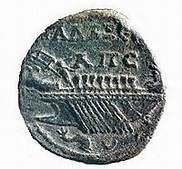
08.06.03.B. GADARA COIN WITH WORD “NAUMACHIA.” A second century (A.D.) “War Galley” coin found at Gadara with the Latin term naumachia was derived from a Greek word meaning mock naval battle. The city had the largest harbor on the Sea of Galilee that was used at times for mock naval battles which entertained the crowds. For more than 250 years, coins depicted boats that reflected upon the grandeur of the city, possibly even back to the days of Jesus. Photo by Wikipedia Commons.
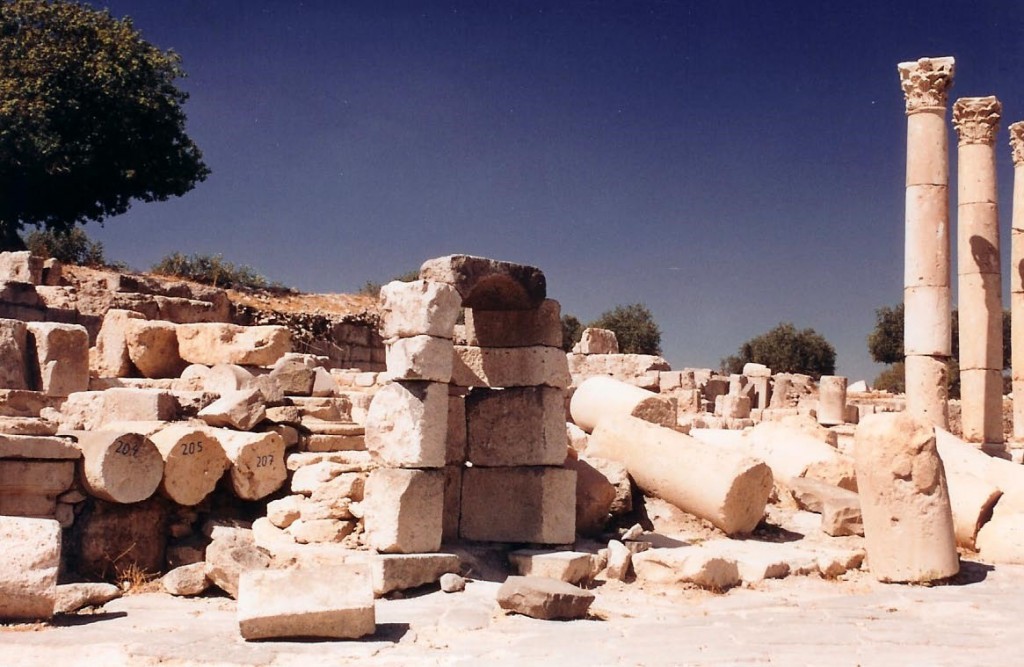
08.06.03.C. VILLAGE RUINS OF GADARA. The modern village of Umm Quas was known in the days of Jesus as Gadara, home of the pig herders. Excavations uncovered a third century church which commemorated the miracle of deliverance of the demoniac. Photograph by the author.
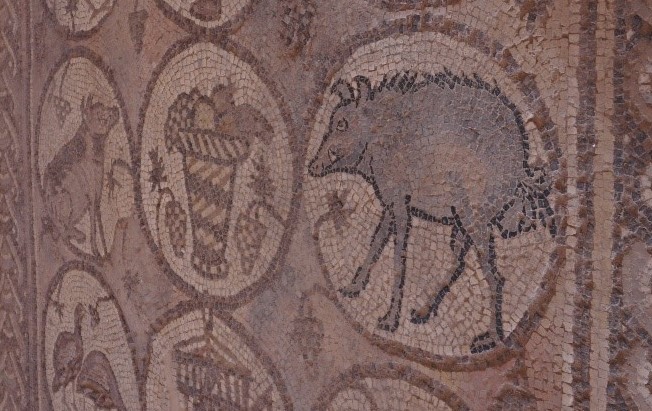
08.06.03.D. A MOSAIC FLOOR FEATURING A VARIETY OF ANIMALS, INCLUDING A WILD BOAR. Domesticated pigs were raised for food and Gentile sacrifice but the wild boar was the mascot for the Roman Tenth Legion. This mosaic was uncovered in Jerash, in Modern Jordan, known as Gerasa in Mark 5:1-10. Photo by Jeff Herot.
08.06.03.Q1 Was Gerasa really the home of the pig farmers (Mk. 5:1; see also 08.06.03.Q3)?
As previously stated, critics have said that since Gerasa more than six miles from the miracle site, the biblical account cannot be seriously considered as true because domesticated pigs cannot travel that far. Furthermore, since pigs do not have sweat glands they need a cool environment, preferably a wet or muddy area, to regulate body temperature. Otherwise, in this region they would die quickly in the summer heat. Due to the incredibly unpleasant fragrance swine produce, especially two thousand of them, they were maintained far outside and downwind of villages. Their need for water in a semi-arid climate meant they were close to the Sea of Galilee or to one of the small streams that flows into it. It was the Gentile pig owners[30] who lived in Gerasa, not the pigs. Therefore, the biblical narrative stands.
At this point, it is important to recall the origins of the ten cities of the Decapolis. Some fourteen centuries earlier when Joshua entered the land, he drove out the seven pagan tribes of the Canaanites, Hittites, Hivites, Perizzites, Girgashites, Amorites, and Jebusites (Jos. 3:10). Isaiah referred to the Canaanites when they sacrificed pigs on mountaintop altars (65:4-8) and their descendants at the time of Jesus continued the practice.
They were not the only ones who considered pigs to be sacrificial animals; the Romans did likewise. In fact, the emblem of one of the Roman legions, the Decima Fretensis, was the wild boar (pig).[31] Pigs were an important source of food and significant in religious worship. Therefore, it is not surprising that the descendants of the ancient Canaanites, now absorbed into the Greek culture, believed that pigs needed to be sacrificed to their gods. The following is from an inscription written by Epidaurus in the late 4th century A.D., but it reflects the belief of the Inter-Testamental Period. Religions and social values such as these changed little in the course of time.
The cure affected by Apollo and Asclepius. Ambrosia of Athens was blind in one eye. She came with supplications to the god and as she walked around the temple she smiled at the accounts of some of the cures which she found incredible and impossible, accounts which related how the lame and blind had been cured by a vision which came to them in a dream. She fell asleep and had a vision. (In the vision) the god appeared before her, telling her that she would be cured and that she had to dedicate in the sanctuary a pig made of silver as a token of her ignorance. Having said this he (the god)[32] cut out the bad eye and immersed it in a medicine. She awoke at dawn, cured.
Inscription of Epidaurus[33]
When Jesus arrived on the eastern shores of the Sea of Galilee, He was met with a demon-possessed man who was from one of the nearby Decapolis cities. When Jesus spoke to him, he responded by indicating he had a “legion” of demons. A legion was a Roman military unit of about 6,000 soldiers, one hundred horsemen plus cavalrymen, and support troops.[34] Needless to say, this man was seriously possessed with multiple demons. Jesus single-handedly demonstrated His power over a superior number of demonic forces with His spoken word as they recognized and obeyed Him immediately. He made no reference to any incantations, a higher authority, or to God. They knew their own destiny; they would be tortured and rejected forever.[35] This was no doubt an awesome sight for the disciples to witness!
08.06.03.Q2 What is significant about the demons entering the pigs (Mk. 5:1-20)?
At this point in the biblical narrative, the evil spirits entered the pigs, which was another demonstration of the greatness of Jesus and the failure of the pagan gods. The pigs, which evidently were most unhappy and miserable with demons in them, ran down the embankment and into the Sea of Galilee where they drowned by suicide. Ironically, the Greeks believed that the Abyss was at the bottom of the Sea (cf Rev. 9:1; 11:7) where the demons lived. To the Greeks, Jesus not only demonstrated that His power was superior to their gods, but He also sent the evil spirits back to their “home,” and in the process killed a herd of their sacrificial animals.
Centuries earlier, just as God demonstrated His power against the Egyptian gods through Moses and Aaron, so likewise Jesus demonstrated His power against the Greek gods. Little wonder that they asked Him to leave. The Egyptians did the same to Moses. However, God’s grace did not end there.
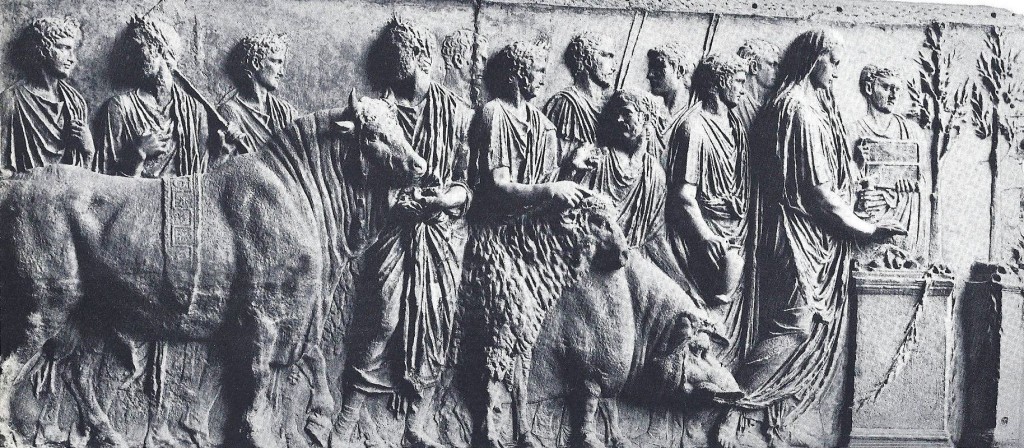
08.06.03.E. A RELIEF OF SACRIFICIAL ANIMALS, INCLUDING A PIG. A ceremony in Rome known as the suvetaurilia, is the sacrifice of a bull, ram and a pig to the god Mars. While this relief is believed to have originated from the era of Emperor Domitian (reigned A.D. 81-96), the cultic practice was already well established for centuries.
When the man freed of demons asked Jesus if he could journey with Him, the request was denied. Rather, Jesus told him to return to his home and tell others of what had happened to him. He did so and evidently prepared the way for Jesus’ visit later as described in Mark 7:31. The gospel had taken root so well in this community that in the first centuries of the early church, whenever there was a church council or gathering to discuss doctrine, policy, or other church business, there was always a representative from Gerasa. This is dynamic evidence again that God desires to use every willing person, even one who had been possessed by demons, to spread His good news, regardless of past events.
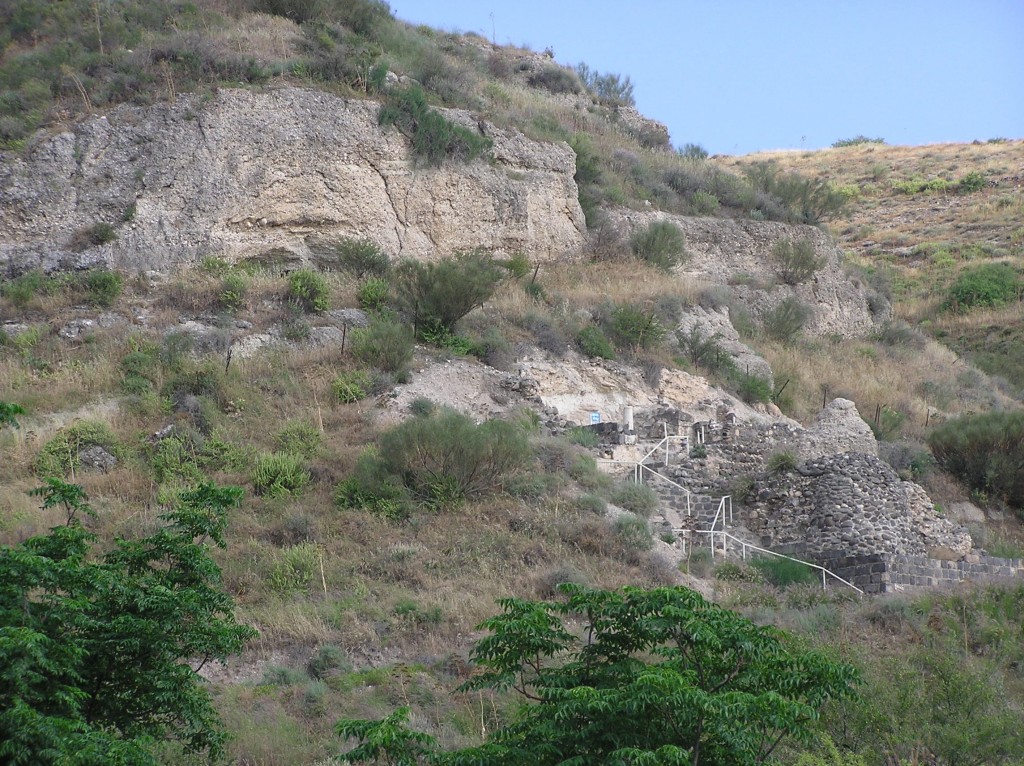
08.06.03.F. RUINS OF THE ORIGINAL KURSI MEMORIAL. A trail goes up a steep hillside to the ruins of a 4th century memorial that commemorated the miracle of the demoniac about six miles from Gadara. Kursi is believed to be the site of the biblical Gergesa which a growing number of scholars believe was incorrectly identified. Photograph by the author.
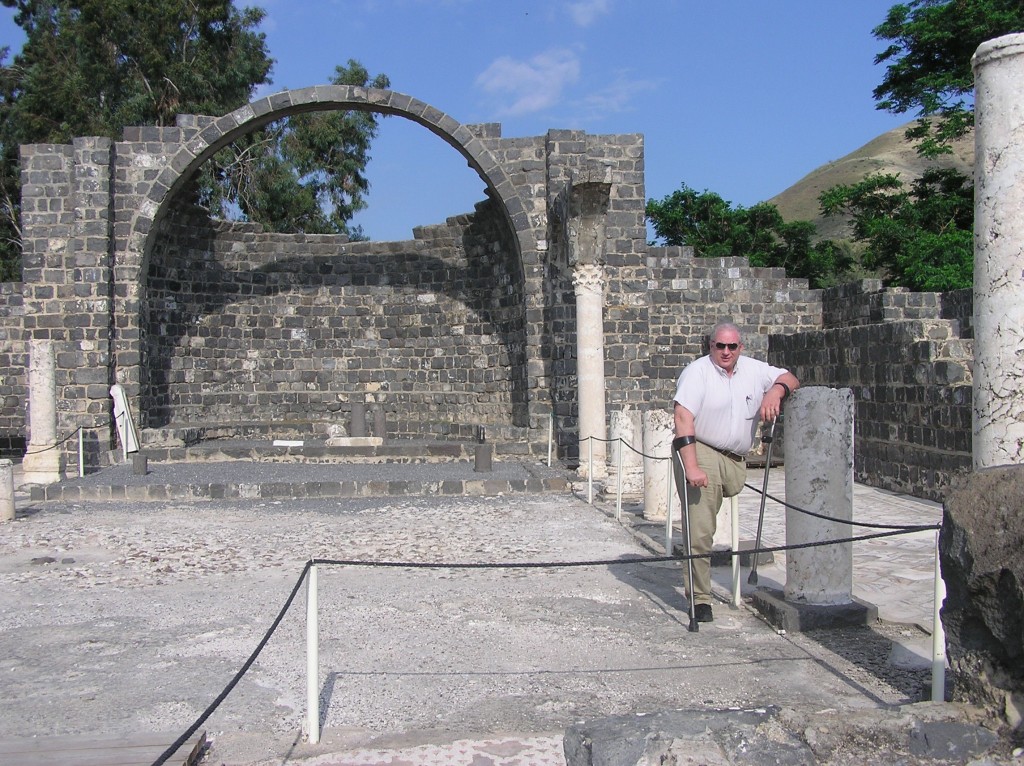 08.06.03.G. THE RUINS OF THE 6TH CENTURY BYZANTINE MONASTRY AT KURSI (ANCIENT GERGESA). The author stands in a 6th century church adjacent to the previous memorial (above) that commemorates the miracle of the demoniac. As with the original memorial, it too was destroyed by an earthquake on January 18, 749.[36] Photograph by Paivi Heinrich.
08.06.03.G. THE RUINS OF THE 6TH CENTURY BYZANTINE MONASTRY AT KURSI (ANCIENT GERGESA). The author stands in a 6th century church adjacent to the previous memorial (above) that commemorates the miracle of the demoniac. As with the original memorial, it too was destroyed by an earthquake on January 18, 749.[36] Photograph by Paivi Heinrich.
Finally, as an interesting side note, the Jews considered the pigs to be unclean and unholy, but the Greeks felt just the opposite – fine dining and the ideal sacrificial animals. So when archaeologists work at a village dig site today, the lack of pig bones is an indicator that the village was a Jewish one, while in Roman or Greek villages there is almost always a discovery of pig bones.
08.06.03.Q3 Why are there name variations for the Gadara region (Mk. 5:1-20; Mt. 8:28-34; Lk. 8:26-39)?
Video Insert >
08.06.03.V1 Interesting Issues of Gadara. Professor Gordon Franz discusses the interesting issues of Gadara, including the clarification of names, the first evangelist to the Gentiles of this region, and the mystery of Gadara’s harbor.
This region southeast of the Sea of Galilee has three communities: Gerasa, Gadara, and Gergesa.[37] There has been much discussion concerning the name “Gadarenes.” Critics have said it does not agree with parallel verses in Mark and Luke that record the town as “the region of Gerasa.” There is no conflict, however, as the latter was the capital of the political district. Regions were often called by the name of their capital cities or by a major city. Gadara was the capital city of the toparchy.[38] The region was known by all three names.[39] In a similar manner, Babylon was the name of a region as well as the name of the region’s capital city. Furthermore, the name Gergesa is Hebrew in reference to the clay ground, while the other two names are Greek.[40] So the gospel writer writing to the Jewish people would use the name Gergesa while those writing to a Gentile audience would use the Gentile names.[41]
Video Insert >
08.06.03.V2 The Mystery of the Harbor of Gadara. Mr. Joel ben Yosef discusses the unique mystery of the harbor of Gadara. Introduction and cultural background comments by Dr. Bill Heinrich.
As previously stated, each gospel writer wrote from his perspective. Matthew stated that the event took place in the region of Gadarenes (v. 28), which was one of the ten taxation districts of the Decapolis. Since Matthew was a former tax collector, it would have been natural for him to refer to a region of the legal tax district. More specifically, the ancient village known as Gadara is now called Umm Qas. It is about six miles southeast of the Sea of Galilee in the district of Gerasa. Since Matthew 8:34 states that the whole town came to plead with Jesus to leave, it can safely be assumed they came from this city.
It was common practice that people and places often had two names. Place names often changed whenever a new foreign power or king ruled the region. For example, in the years following Jesus’ resurrection, Herod Agrippa II renamed Caesarea Philippi to Neronias in honor of Emperor Nero. However, after Nero committed suicide, the name was quickly changed to Paneas, the original name prior to Caesarea Philippi. Other names of this city are Banias, Banyas, Baniyas, Paneas, Panias, Paneias, Paneion, and Panium. Therefore, confusion of the name of Gadara and its regions around it confirm that this biblical passage is authentic to fluid changes of first century life in the Holy Land.[42]
08.06.03.Q4 Were there one (Mk. 5:2) or two demoniacs (Mt. 8:28)?
One of the challenges scholars have had, has been to reconcile the differences of these passages. Some critics have said these narratives were created in the second or third centuries by church leaders. If what they say is true, then the phantom church writers made huge errors because anyone fabricating an event would not deliberately write a narrative with problems. Why, then, did the gospel writers record the obvious differences?
Matthew refers to two demoniacs as being healed while Mark and Luke said only one was healed. Critics have stated that this reflects Matthew’s exaggeration of the story to make a theological statement. Furthermore, critics have said that the point of the gospels is not to give a chronological account of the life of Christ, but to construct an interpretative portrait of a man with a religious agenda. They assume that the scribe writing the portrait was never interested in factual historical events, but only in the message of the individual who is portrayed.
In this narrative, when Jesus came close to the demoniacs, they placed themselves on the ground before Him, indicating they recognized who He was and willingly submitted themselves to Him. Demons will always recognize the authority of Jesus and, the fact, that He is their judge. The precise reason why Mark and Luke recorded only one individual may never be known. We can only conclude that Matthew reported that there were two, and the fact that the other writers reported only one does not mean that a second individual was not present. Mark and Luke both noted that after the man was healed, he was dressed, in his right mind, and listening to Jesus. Suggestions for the differences between Matthew and the two other accounts are as follows:
- Mark recorded that one demoniac met Jesus as He got out of the boat. The entire discourse appears to have been between Jesus and this single demon-possessed man. If a second demoniac stayed in the background, it would be normal for Mark and Luke to refer only to the one Jesus encountered.[43]
- One demoniac was more notable to the community than the other
- Since only one appears to have been set free of his evil hosts, the second demoniac may have retreated into a tomb, or at least, did not offer himself to be set free. Hence, his account did not become part of the biblical record.
Notice that one of the two demoniacs was very vocal and made some profound statements. Mark and Luke said that the demon-possessed man recognized Jesus by calling Him “Son of the Most High God,” and when Jesus took control of the conversation by asking him his name, he answered, “Legion.” The focus of the biblical narrative is not on the number of individuals who were healed, but on how Jesus took command of the most serious situation: the demons obeyed Him.
Matthew was a Pharisee and certainly knew the Mosaic Law. He quoted Deuteronomy 19:15 (Mt. 18:16) to say that all matters are to be settled with two or three witnesses (Deut. 17:6). Since he was conscious of the function of the law, he made certain that his readers understood that there were two men who were healed and were witnesses of the divine power of Jesus. Mark and Luke appear not to have an equal concern to reflect this law. Apparently, they felt that because of the divine majesty of Christ, they did not have to underscore the event with a record of a second witness. It is important to remember that the ancient mind-set was different from western thought and logic. Some elements of an event that are considered critical today were considered unimportant in the first century. The perspective from which Mark and Luke wrote their accounts is actually rather easy to understand.
This author recalls a class of Russian students he once taught in Israel in which two women were not only very vocal, but were very intelligent and knowledgeable of Scripture. Upon reflection of the class Bible students, he can only remember these two women because they made a lasting impression on him. Likewise, clearly one of these two demoniacs made a lasting impression on Mark and Luke.
08.06.03.Q5 If Jesus cursed Capernaum, Chorizim, and Bethsaida, why didn’t He curse Gadara?
When considering that the three villages of Capernaum, Chorizim, and Bethsaida were cursed by Jesus for their rejection of Him, the question arises as to why He didn’t do likewise to the Greek city of Gadara. The Greeks were certainly more adamant about sending Jesus on His way than were the Jews who politely rejected Him. Scripture is silent on the matter, but apparently He may have done so. The first century historian preserved an interesting account on the subject.
History records that not only did Gadara fall to the Romans, but it was the first Greek city to fall. Josephus recorded that when the First Revolt started (66 A.D.), all its youth were killed and other residents were sold in the slave markets. He wrote:
So Vespasian marched to the city Gadara and took it upon the first onset, because he found it destitute of any considerable number of men grown up and fit for war. He came then into it and slew all the youth, the Romans having no mercy on any age whatsoever; and this was done out of hatred they bore the nation … He also set fire, not only to the city itself, but to all the villas and small cities that were round about it; some of them were quite destitute of inhabitants and out of some of them he carried the inhabitants as slaves into captivity.
Josephus, Wars 3.7.1 (132-134)[44]
Apparently Jesus did curse the city, and its destruction came quickly – long before it came to Capernaum, Chorizim, and Bethsaida. The Gadara residents were witnesses to the great and mighty miracles and most certainly were aware of His ministry only a short distance across the lake. Jesus granted them many years to repent, but evidently they chose not to and their city was destroyed. The survivors of the Roman massacre who escaped the carnage rebuilt Gadara, but it was destroyed again on January 18, 749 by an earthquake (estimated 6.6 Richter scale).[45] It was never rebuilt although with the migration of Arabs, a new village was established nearby. Jesus demonstrated His compassion for those who were demonically possessed. But rather than accepting Him, they were fearful. In fact, they were more fearful of Jesus than of the demoniac before he was healed, not to mention their concern for their lost pigs.
Some scholars, especially those with an interest in biblical prophecy, have noted that the site of the miracles is adjacent to what may someday be called a Valley of Judgment, a/k/a the Valley of Hammon Gog. Ezekiel prophesied (39:11) that an apocalyptic battle of the armies of Gog and Magog will one day fight Israel and the invaders will be buried in a valley east of the Sea of Galilee. The Valley of Hammon Gog (Hamon-gog), known today as the Wadi Semakh, best fits the geographical description and it is at the western edge of this wadi that these miracles occurred. The prophecy is
Now on that day I will give Gog a burial place there in Israel — the Valley of the Travelers east of the Sea. It will block those who travel through, for Gog and all his hordes will be buried there. So it will be called the Valley of Hamon-gog.
Ezekiel 39:11
Jesus returned to His home in Capernaum, saddened, but not in anger. Their rejection was strikingly similar to that of the Pharisees. But now there was one soul saved and healed who was going through various Decapolis cities proclaiming the radical change Jesus performed in His life. History would reveal the fruitfulness of his work.
08.06.03.Q6 What happened to the healed demoniac (Mk. 5:1-20)?
History has forgotten what happened to him, but evidently he became a significant figure in the Decapolis region. Only a few months later Jesus returned to the eastern side of the Sea of Galilee and fed thousands by a miracle of bread and fish. That miracle of multiplication resulted with seven large baskets filled with leftovers. Clearly the miracle of exorcism resulted in a radical change of attitude for many of the local Gentiles. A hundred years later a significant church was established in Gadara headed by a bishop. By the second century the city was home to several churches, and by the fourth century, it was the seat of one of the most important bishops in the early church. One can never overestimate the power of God to transform a life and make it significant for future generations.[46] Christianity spread quickly and by 325, the church of Gadara sent a bishop to the highly esteemed Council of Nicea.[47] A bishop from the nearby city of Hippos was also present at the first Church Councils of Nicea and Constantinople. It appears that the demoniac became an important and outstanding apostle and evangelist. This is an example of how quickly Christianity took root in the Greek cities.[48]
[1]. Lang, Know the Words of Jesus. 60.
[2]. There were four legions stationed in the province of Syria. While Judaea was considered part of Syria, it had a number of military units but no legions. Webb, “The Roman Examination and Crucifixion of Jesus.” 725; See also Josephus, Antiquities 17.10.2-3, Wars 2.3.1-4; 2.17.7-8; 5.4.3-4; Hendin, Guide to Biblical Coins. 118-19.
[3]. Pagan priests praying and offering sacrifices on behalf of Roman soldiers is portrayed very well in the movie Masada, starring Peter O’Tool.
[4] Trench, Notes on the Miracles of Our Lord. 133.
[5]. Edersheim, The Life and Times of Jesus the Messiah. 419.
[6]. Barclay, “Mark.” 60.
[7]. http://en.wikipedia.org/wiki/Exorcist. Retrieved August 10, 2013.
[8]. These same distinctions were made in Lk. 6:18; 7:21; 8:2; 13:32.
[9]. See Appendix 32 and Evans, Praying through the Names of God. 21-22.
[10]. A toparchy was the Roman classification for this district. Sherwin-White, A. N. Roman Society and Roman Law in the New Testament. 128-30.
[11]. For more details, read Josephus, Antiquities, 13.13.3 through 14.5.4.
[12]. Geikie, The Life and Words. 2:628-29.
[13]. Geikie, The Life and Words. 2:629; Vincent, Word Studies in the New Testament. 1:53.
[14]. For further study on binding and loosening see 08.04.07.Q1 “What verbal formulas did exorcists use when casting out demons?” the account of the demoniac whom Jesus cleansed in 08.06.03; the phrase “Bound in heaven . . . loosed in heaven,” in 11.02.08; the phrase “Bind on earth … loose on earth” in 10.01.29; and the phrase “Lord, even the demons submit to us in Your name,” in 12.01.03. An excellent resource for further study was written by Foster and King, Binding and Loosening: Exercising Authority over Dark Powers.
[15]. Hendin, Guide to Biblical Coins. 118-19.
[16]. An illustration of a roof tile found in Jerusalem has the engraved image of a ship and wild boar and Tenth Legion initials. See 06.03.09.C.
[17]. Mk. 5:12, 15; 3:22, 30; Lk. 4:33.
[18]. Lk. 10:17-18; 11:19-20.
[19]. 1 Cor. 10:20-21.
[20]. Rev. 9:20; 16:13-14.
[21]. 1 Tim. 4:1.
[22]. Lk. 13:11, 16; Mk. 5:2-5; 7:25; Mt. 12:45.
[23]. http://israel-tourguide.info/2011/01/10/earthquakes-history-archaeology/. Retrieved on August 25, 2014. See also http://geology.geoscienceworld.org/content/31/8/665.abstract and http://en.wikipedia.org/wiki/749_Galilee_earthquake Retrieved on August 25, 2014.
[24]. Tzaferis, “A Pilgrimage to the Site of the Swine Miracle.” 47.
[25]. Pliny, Natural History 5.74; Josephus, Antiquities 17.11.4; Lightfoot, A Commentary on the New Testament from the Talmud and Hebraica. 1:239-40.
[26]. See 08.06.02.A.
[27]. Franz, “Ancient Harbors of the Sea of Galilee.” 35-36; Hendin, Guide to Biblical Coins. 160-62.
[28]. Farrar, Life of Christ. 42.
[29]. Josephus, Antiquities 17.2.4.
[30]. There is an old opinion that the pigs were raised by apostate or Hellenized Jews. However, that theory has in recent decades been proven wrong and is now universally agreed upon by scholarship.
[31]. Pixner, With Jesus through Galilee. 43; Hendin, Guide to Biblical Coins. 118-19.
[32]. Parenthesis for clarification are mine.
[33]. Boring, Berger, and Colpe, eds. Hellenistic Commentary to the New Testament. 65; Giannelli, The World of Classical Athens. 211.
[34]. Lang, Know the Words of Jesus. 60. Historians differ in the size of various military groups.
[35]. Jude 6; Rev. 20:10; cf. 1 Enoch 16:1; Jubilees 10:8-9; Testament of Levi 18:12; 1QS 3:24-25; 4:18-20.
[36]. See http://israel-tourguide.info/2011/01/10/earthquakes-history-archaeology/ Retrieved August 25, 2014. The Jordan valley is one of the most active earthquake zones in the world. There have been hundreds of minor earthquakes and major ones have dammed the Jordan River repeatedly, sometimes for days, in 1160, 1267, 1534, 1834, 1906 and 1927. At such times, buildings are destroyed, thousands of lives are lost, and the river often redirects itself as a new river bed is formed.
[37]. See Map of Decapolis Cities and Region, 03.04.17.Z.
[38]. Sherwin-White, Roman Society and Roman Law in the New Testament. 128.
[39]. Stern, Jewish New Testament Commentary. 90.
[40]. Lightfoot, A Commentary on the New Testament from the Talmud and Hebraica. 1:152.
[41]. See 08.06.03.V1.
[42]. Geikie, The Life and Words. 2:628-30.
[43]. Archer, Encyclopedia of Biblical Difficulties. 325.
[44]. See also Josephus, Wars 4.7.3.
[45]. http://israel-tourguide.info/2011/01/10/earthquakes-history-archaeology/. Retrieved on August 25, 2014. See also
http://geology.geoscienceworld.org/content/31/8/665.abstract and http://en.wikipedia.org/wiki/749_Galilee_earthquake Retrieved on August 25, 2014.
[46]. Kraeling, Gerasa: City of the Decapolis. 256, 311-13.
[47]. Cox, “Gadara, Gadarenes.” 2:375-76.
[48]. Pixner, With Jesus through Galilee. 46.